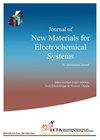Nano Additives in Cashew Nut Shell Liquid Biodiesel and Environment Emissions of Diesel Engine
IF 0.6
4区 材料科学
Q4 ELECTROCHEMISTRY
Journal of New Materials For Electrochemical Systems
Pub Date : 2022-06-10
DOI:10.14447/jnmes.v25i2.a01
引用次数: 0
Abstract
The developing countries are using non-edible oils for the production of biofuels, additives, or alternate fuels. The research article focused on the behavior study and analysis of cashew nut shell liquid (CNSL) biodiesel obtained by processing the cashew nut shell liquid. The work is carried out to derive the thermal-cracked (TC) -CNSL oil from Cardonal in the temperature range l50℃ to 400℃. The chemical functional groups are studied using Fourier-transform infrared spectroscopy (FTIR) and gas chromatography-mass spectrometry (GCMS) techniques. The TC-CNSL blended fuel performance is compared with diesel and neat biodiesel (B-100). The physicochemical properties of diesel, CNSL, and TC-CNSL biodiesel are estimated based on American Society for Testing and Materials (ASTM) standards. The 50 parts per million (ppm) Cerium Oxide Nanoparticles are added with TC-CNSL-B25, TC-CNSL-B50, TC-CNSL-75, and TC-CNSL-BJOO and processed in a single stroke diesel engine working at constant speed 1500-rpm. The blended fuel is analyzed based on environmental emission parameters in the diesel engines. The carbon monoxide (CO), carbon dioxide (CO2) hydrocarbon (HC) emissions of B-100 are reduced by 40.5%, 60.9%, and 30.7% respectively in comparison to diesel, at full load. The nitrogen oxide (NOx) emissions are increased by 13.26 % in B-100 in comparison to diesel, at full load. The smoke density is also observed decreasing in B-100 in comparison to diesel.腰果壳液体生物柴油中的纳米添加剂与柴油机环境排放
发展中国家正在使用非食用油生产生物燃料、添加剂或替代燃料。本研究主要对腰果果壳液(CNSL)生物柴油的性质进行了研究和分析。在150℃~400℃的温度范围内,从Cardonal中得到了热裂解(TC)-CNSL油。利用傅立叶变换红外光谱(FTIR)和气相色谱-质谱(GCMS)技术对化学官能团进行了研究。将TC-CNSL混合燃料的性能与柴油和纯生物柴油(B-100)进行了比较。柴油、CNSL和TC-CNSL生物柴油的物理化学性质是根据美国材料试验协会(ASTM)标准估计的。将百万分之50(ppm)的氧化铈纳米粒子加入TC-CNSL-B25、TC-CNSL-B50、TC-CNSL-75和TC-CNSL-BJOO,并在以1500rpm的恒定速度工作的单冲程柴油发动机中进行处理。基于柴油机环境排放参数对混合燃料进行了分析。B-100的一氧化碳(CO)、二氧化碳(CO2)碳氢化合物(HC)排放量与柴油相比,在满载时分别减少了40.5%、60.9%和30.7%。与柴油机相比,B-100的氮氧化物(NOx)排放量在满载时增加了13.26%。与柴油机相比,B-100的烟密度也有所下降。
本文章由计算机程序翻译,如有差异,请以英文原文为准。
求助全文
约1分钟内获得全文
求助全文
来源期刊

Journal of New Materials For Electrochemical Systems
ELECTROCHEMISTRY-MATERIALS SCIENCE, MULTIDISCIPLINARY
CiteScore
1.90
自引率
0.00%
发文量
33
审稿时长
>12 weeks
期刊介绍:
This international Journal is intended for the publication of original work, both analytical and experimental, and of reviews and commercial aspects related to the field of New Materials for Electrochemical Systems. The emphasis will be on research both of a fundamental and an applied nature in various aspects of the development of new materials in electrochemical systems.
 求助内容:
求助内容: 应助结果提醒方式:
应助结果提醒方式:


